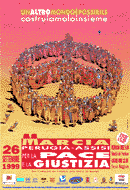
March for peace Perugia Assisi 1999
The History of the Perugia/Assisi March - Part II
Back to index
[...]
The following characteristics of the March have been clear to me since 1960:
1) the event should start from an independent and integrally pacifist group (the Perugia Centre for Non-violence)
2) the March should awake people to the danger that peace is in, even the most isolated people and those who keep themselves at distance from mass information and politics
3) the March should represent an occasion to present and "thrust" the idea of non-violent methods to unaware, reluctant and even opposed people
4) there should be a reference to the Italian Saint who preached non-violence (and who was a reformer, though unsuccessful) [...]
After we started our work in an attempt to inform and involve as many people as possible, we realised that, as far as the date of the March was concerned, we had to renounce the idea of making it soon. Therefore, after setting various deadlines, we concluded on September 24, 1961, which, as the results showed, was a very good choice. In the months leading up to June 1961, we couldn't say we had got much support and engagement for participation (which was declared by sending the coupons that we'd attached on the invitation circular). (...) Therefore, starting from July, when my teaching term was over, I engaged in very hard work - our "delivery" term was getting nearer and we there was no way we could go back - in order to spread the news. Those who attended the March and saw what variety of people there was, from religious minorities to pacifist groups (which were together for the first time), don't know that I was hoping to see even more, with a much more consistent quantity of our banners. This, too, indicates that the Perugia-Assisi March was the activator of a type of integral and non-violent pacifism much bigger and more dynamic than the one we had before. Now, we can count on much more people, on more people of goodwill, on a distinguished willingness to co-operate. This shows that the March made it emerge and compacted it: the old pacifism was fragmentary, sometimes even "sedentary", and generally quite distant from the multitudes who might have been willing to join integral pacifism (there were some women with tears in their eyes at the passage of our March; I saw some farmers taking off their hats). (...) Before the March, we received a wide range of blames: some said I was being manipulated by the communists, some accused me of having organised the "vegetarians'" march. On September 14, 1961, "Il Borghese" closed its article about the March saying that "Thinking it over again, on balance, between vegetarians and simpletons, we'd prefer the simpletons".